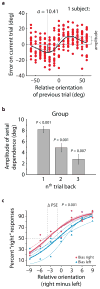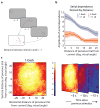Serial dependence in visual perception
- PMID: 24686785
- PMCID: PMC4012025
- DOI: 10.1038/nn.3689
Serial dependence in visual perception
Abstract
Visual input often arrives in a noisy and discontinuous stream, owing to head and eye movements, occlusion, lighting changes, and many other factors. Yet the physical world is generally stable; objects and physical characteristics rarely change spontaneously. How then does the human visual system capitalize on continuity in the physical environment over time? We found that visual perception in humans is serially dependent, using both prior and present input to inform perception at the present moment. Using an orientation judgment task, we found that, even when visual input changed randomly over time, perceived orientation was strongly and systematically biased toward recently seen stimuli. Furthermore, the strength of this bias was modulated by attention and tuned to the spatial and temporal proximity of successive stimuli. These results reveal a serial dependence in perception characterized by a spatiotemporally tuned, orientation-selective operator-which we call a continuity field-that may promote visual stability over time.
Figures




Comment in
-
Spatiotemporal context. How past perception influences current perception.Atten Percept Psychophys. 2014 Jul;76(5):1254-5. Atten Percept Psychophys. 2014. PMID: 25140371 No abstract available.
References
-
- Webster MA. Pattern selective adaptation in color and form perception. The visual neurosciences. 2003;2:936–947.
-
- Fang F, He S. Viewer-centered object representation in the human visual system revealed by viewpoint aftereffects. Neuron. 2005;45:793–800. - PubMed
-
- Clifford CW, Wyatt AM, Arnold DH, Smith ST, Wenderoth P. Orthogonal adaptation improves orientation discrimination. Vision Res. 2001;41:151–159. - PubMed
-
- Dragoi V, Sharma J, Sur M. Adaptation-induced plasticity of orientation tuning in adult visual cortex. Neuron. 2000;28:287–298. - PubMed
-
- Kohn A. Visual adaptation: physiology, mechanisms, and functional benefits. Journal of neurophysiology. 2007;97:3155–3164. - PubMed
Publication types
MeSH terms
Substances
Grants and funding
LinkOut - more resources
Full Text Sources
Other Literature Sources
Miscellaneous

